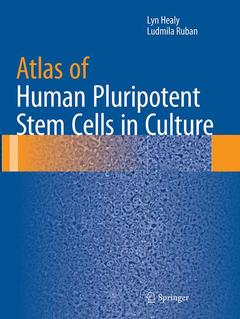Description
Atlas of Human Pluripotent Stem Cells in Culture, Softcover reprint of the original 1st ed. 2015
Language: English
Subjects for Atlas of Human Pluripotent Stem Cells in Culture:
Publication date: 09-2016
Support: Print on demand
Publication date: 11-2014
206 p. · 21x27.9 cm · Hardback
Description
/li>Contents
/li>Biography
/li>Comment
/li>
This lavishly-illustrated, authoritative atlas explores the intricate art of culturing human pluripotent stem cells. Twelve chapters ? containing more than 280 color illustrations ? cover a variety of topics in pluripotent stem cell culturing including mouse and human fibroblasts, human embryonic stem cells and induced pluripotent stem cells, characteristic staining patterns, and abnormal cultures, among others. Atlas of Human Pluripotent Stem Cells in Culture is a comprehensive collection of illustrated techniques complemented by informative and educational captions examining what good quality cells look like and how they behave in various environments. Examples of perfect cultures are compared side-by-side to less-than-perfect and unacceptable examples of human embryonic and induced pluripotent stem cell colonies. This detailed and thorough atlas is an invaluable resource for researchers, teachers, and students who are interested in or working with stem cell culturing.
1 Before We Begin: An Introduction to the Culture of Pluripotent Cells.- 2 Mouse and Human Fibroblasts.- 3 Inactivated Mouse and Human Fibroblasts.- 4 Human Embryonic Stem Cells.- 5 Human Induced Pluripotent Stem Cells on Feeders.- 6 Pluripotent Cell Lines Grown on Different Substrates and Surfaces.- 7 Passaging Pluripotent Stem Cells.- 8 Characteristic Staining Patterns of Undifferentiated and Differentiated Pluripotent Stem Cells.- 9 Derivation of Induced Pluripotent Stem Cells.- 10 Culture Adaptation and Abnormal Cultures.- 11 Infection.- 12 Miscellaneous Cell Types and Cell Lines of Interest.
Dr. Lyn Healy started her training at the Paterson Institute for Cancer Research in Manchester, England, in the experimental hematology laboratory of Dr. T. M. Dexter, where she obtained her master’s degree. From there, she moved to London’s Institute of Cancer Research, where she worked in the Leukemia Research Fund Centre and obtained her Ph.D from the University of London on stem cells in normal and leukemogenic hemopoiesis. She joined the United Kingdom Stem Cell Bank (UKSCB) at the National Institute for Biological Standards and Control as the Senior Stem Cell Biologist. Dr. Healy runs the research and development program at the UKSCB and plays an active role in training scientists in pluripotent stem cell culture. She has collaborated on training courses hosted by the Centre for Stem Cell Biology in Sheffield and has run courses at the UKSCB. In addition, she set up the UKSCB Technical Forum where scientists discuss and resolve practical challenges in the field of stemcell culture. Dr. Healy has published more than forty peer-reviewed papers on stem cell biology.
Ludmila Ruban obtained her MSc in physiology at the University of Kiev, Ukraine. She began work on human embryonic stem cells (hESC) in Peter Andrews’ and Harry Moore’s laboratory in Sheffield University, which later became the Centre for Stem Cell Biology. This group was one of the first in the United Kingdom and Europe to start working with the Wisconsin human embryonic stem cell lines. The Centre has been awarded one of the first two licenses granted by the U.K. Human Fertilisation and Embryology Authority for derivation of hESC, and she has helped derive several new stem cell lines. She was also actively involved in the training of national and international researchers within the Centre and coordinated, organized, and taught at the Centre's annual practical training course for academics, “Working with Human Embryonic Stem Cells." She joined the Department of Biochemical En




